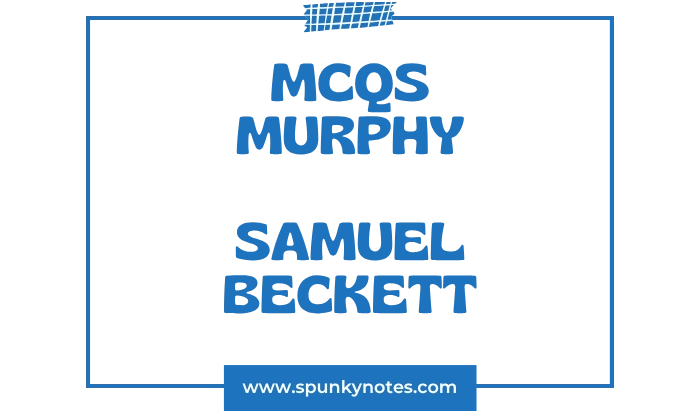

Estimated Reading Time: 16 min
Murphy MCQs
1. Where does Murphy sit naked?
A. Dublin flat
B. Mew in West Brompton
C. Cork County mew
D. Neary’s cottage
2. What is Murphy’s rocking chair made of?
A. Polished oak
B. Undressed teak
C. Hard-worn canvas
D. Guaranteed plastic
3. What is Murphy secured with in his chair?
A. Leather straps
B. Ropes and chains
C. Seven scarves
D. Wire and twine
4. What chant bothers Murphy?
A. God bless you
B. Quid pro quo
C. Love requited
D. All is dross
5. What pleasure does restraining his body give Murphy?
A. Stronger muscles
B. Mental freedom
C. Better sleep
D. Physical pain
6. Who was Murphy’s tutor in Cork?
A. Miss Dwyer
B. Mr. Kelly
C. Neary
D. Dr. Fist
7. What physiological skill did Neary master?
A. Stopping his heart
B. Extreme fasting
C. Walking on water
D. Controlling blood
8. What did Neary call the blend of Murphy’s heart extremes?
A. The Ammonia
B. The Paradox
C. The Chaos
D. The Isonomy
9. How did Neary summarize all life?
A. Love and loss
B. Figure and ground
C. Chaos and order
D. Flesh and spirit
10. What did Neary call requited love?
A. Great fulfillment
B. A short circuit
C. Pure happiness
D. Ultimate desire
11. What part of Murphy did Neary suggest had shrunk?
A. His liver
B. His heart
C. His conarium
D. His scrotum
12. Who interrupts Murphy’s rocking?
A. His landlady
B. The telephone
C. Neary ringing
D. Celia knocking
13. Who is the caller Murphy speaks to?
A. Miss Counihan
B. His landlady
C. Celia
D. Miss Dwyer
14. What are Celia’s hips affectionately called?
A. My dear loves
B. Hips, etc.
C. The fiery darts
D. My best asset
15. Who is Celia’s paternal grandfather?
A. Flight-Lieutenant Elliman
B. Mr. Willoughby Kelly
C. Father Fitt
D. Neary
16. How did Celia meet Murphy?
A. At a dance
B. On the street
C. In a cafe
D. At the M.M.M.
17. What item did Murphy drop upon meeting Celia?
A. His glasses
B. A star chart
C. A piece of paper
D. His gloves
18. Where did Murphy propose marriage to Celia?
A. Dublin Zoo
B. Cork harbor
C. Battersea Park
D. West Brompton
19. What book was Murphy resting on when he proposed?
A. City of the Sun
B. The Bible
C. Doctrine of the Limit
D. The Iliad
20. Where is Murphy originally from?
A. Cork
B. Ringsakiddy
C. Dublin
D. London
21. What did Murphy claim he had already invested in working?
A. A small fortune
B. His entire savings
C. Neary’s money
D. Celia’s earnings
22. What phrase did Murphy use to describe work?
A. End of them both
B. Necessary evil
C. Figure and ground
D. Apmonia achieved
23. What does Celia tell Murphy she has procured?
A. A better flat
B. A job offer
C. A corpus of incentives
D. New teak chair
24. What comparison comforts Celia before seeing Murphy?
A. Love is a bailiff
B. Murphy is free
C. Her heart is whole
D. Neary will help
25. What did Murphy say about Celia’s efforts to change him?
A. Avoid exhaustion
B. She cannot love
C. It is equitable
D. That is Greek
26. What does Murphy say Celia does?
A. A fraction of what she is
B. More than she knows
C. A total fabrication
D. Everything for him
27. Who is the author of the nativity chart?
A. Mr. Kelly
B. Neary
C. Ramaswami Krishnaswami Suk
D. Flight-Lieutenant Elliman
28. What does Suk’s reading call Murphy’s heart chart?
A. My life-warrant
B. Corpus of deterrents
C. Separation order
D. My little bull
29. What is Murphy’s motto in business, according to Suk?
A. Work or starve
B. Keep trying hard
C. Large profits, quick turnover
D. Avoid publishers
30. Where did Neary try to break Wylie’s arm?
A. In the saloon
B. In the G.P.O.
C. At the statue
D. On the tram
31. What animal ratio was Mr. Kelly’s brain sinking toward?
A. A small bird
B. A badger
C. A Dachshund
D. A sheep
32. What reason did Neary give for shaving his beard?
A. Discharge of a vow
B. Miss Counihan asked
C. To look younger
D. For a disguise
33. What kind of hospital did Ticklepenny work at?
A. Magdalen Mental Mercyseat
B. Cork County Asylum
C. Royal Free Hospital
D. Chelsea Infirmary
34. What two concepts did Murphy relate to Ticklepenny’s job?
A. Poet and nurse
B. Lùnatic and custodian
C. Scholar and drunk
D. Apnoea and fits
35. What name did Murphy affectionately give to the hospital?
A. Zion’s antipodes
B. The great wen
C. A glorious grave
D. The little world
36. What biscuits were part of Murphy’s lunch ritual?
A. Ginger, Osborne, Digestive
B. Shortbread, Wafers, Ginger
C. Marie, Digestive, Wafers
D. Petit Beurre, Chocolate, Ginger
37. What type of dog was Nelly, Miss Dew’s pet?
A. Terrier
B. Poodle
C. Dachshund
D. Spaniel
38. What physical condition afflicted Miss Dew?
A. Duck’s disease
B. Paralysis
C. Bright’s disease
D. Fits
39. How did Murphy picture his mind internally?
A. A buzzing confusion
B. A large hollow sphere
C. A complex machine
D. A wide open world
40. Which zone of Murphy’s mind held “Belacqua bliss”?
A. The light
B. The dark
C. The half light
D. The hidden core
41. What happened to the “old boy” upstairs from Celia?
A. He moved out
B. He cut his throat
C. He went to hospital
D. He returned to Cork
42. What name did the mental nurse Bom share with his twin?
A. Clinch
B. Ticklepenny
C. Cooper
D. Neary
43. What patient was Murphy assigned to watch (his “tab”)?
A. Mr. Higgins
B. Mr. O’Connor
C. Mr. Endon
D. Dr. Killiecrankie
44. What was Mr. Endon’s one known “frivolity”?
A. Playing the piano
B. Chess
C. Darts
D. Reading novels
45. What kind of round was finished on time in M.M.M.?
A. A fast one
B. A virgin
C. An Irish virgin
D. A standard
46. What did Murphy see in Mr. Endon’s eye?
A. The universe
B. His own image
C. Total bliss
D. Nothing at all
47. What did Murphy throw away after his night shift?
A. His key
B. His clothes
C. His chair
D. His star chart
48. What caused Murphy’s death?
A. Heart attack
B. Suicide
C. Gas explosion
D. Gunshot wound
49. What was Murphy’s final instruction for disposing of his remains?
A. Burial in Cork
B. Cremation and scattering
C. Abbey Theatre toilet
D. Given to Celia
50. What happened to Murphy’s ashes?
A. Given to Celia
B. Sent to his uncle
C. Swept from the pub floor
D. Flushed at the Abbey
Brief Overview
Murphy is a novel by Samuel Beckett, first published in 1938. It is a comic masterpiece, considered one of Beckett’s most enjoyable works. The novel satirizes philosophical dilemmas, primarily exploring the mind-body split, isolation, and existential paralysis.
The novel begins with the character Murphy living in London. He seeks inner peace by sitting naked and tied to his rocking chair, a practice that frees his mind from the external world. He lives with Celia, a próstitute who loves him deeply.
Celia forces Murphy to look for a job because they have no money. Murphy uses a humorous horoscope, the Thema Coeli, to guide his job search. He finds work as a male nurse at the Magdalen Mental Mercyseat (M.M.M.), a mental hospital. He leaves Celia to start the job, knowing this action will destroy their life together.
Murphy feels happier at the asylum because he feels a strong connection to the patients. He feels a pure love for a schizophrénic patient named Mr. Endon. Murphy believes Mr. Endon lives ideally within his own mind, a state Murphy desires.
One night, Murphy returns to his garret room and ties himself to the rocking chair. He is tragically killed by fire when the gas radiator ignites. Celia and his searching friends, Neary and Wylie, come to identify his burned remains.
Murphy’s last, absurd request is to have his ashes burned and flushed down a toilet in the Abbey Theatre in Dublin. Cooper, Neary’s servant, carries the ashes to a pub. He throws the ashes at a man during a pub brawl, and they are scattered on the floor to be swept up later with the trash.


